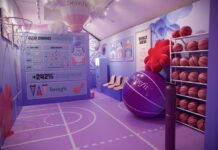Has your business adapted or changed in the last three years? In lean economic times, you must be at the forefront of technology. Doing so can help you get ahead of the competition, find new leads and retain the customers you have. Augmented reality (AR) is one way retailers are doing this. Below, we find out how it can help your company.

What is Augmented Reality?
Augmented reality is a technology that takes real-world locations or objects and imposes digital images, graphics and text on them. Usually, this is done when the object is viewed through a mobile device and app. This can then provide additional information or be used for entertainment purposes, enhancing the overall experience. It blurs the line between the actual and digital world.
AR has followed a wider trend that involves incorporating and blending the digital with the real. One use is with street art in many major capitals, such as Lisbon and Budapest. With the use of AR, specially designed pictures can come to life, moving and providing information on the area.
In entertainment, this blurring of the real and digital can be found in virtual sports betting. These are entirely digital sports, taking the real-world rules and concepts. With the use of a random number generator, people can bet on them. This can be seen as an extension of the popularity of esports betting. This is betting on real video games, with the process of how to bet on esports becoming easier than ever.
Top AR Trends

One of the most interesting and easily applicable ways to introduce AR is to use it to enhance an in-store experience. This allows customers to find extra product information, access inventories, and even view the outfit in different styles, and colours or match it with accessories and other outfits.
Retailers have also reversed this, and instead of having the focus being on in-store applications, have allowed people to see products in their own homes. This is particularly good for home furnishings, where people can place AR sofas or cabinets in their existing spaces to see how they fit and match them with other design elements.
It can also be used on the web itself. AR lets customers view products on themselves before buying. For example, they may superimpose a dress over a picture to see how it looks.
Finally, it can be used to customise products and services on offer. An AR catalogue may let buyers add features or elements, which can be purchased and then made in a bespoke format for them.
Implementing AR
AR does require the use of an app, which isn’t cheap to develop. To create this, you will need to find a dedicated AR app development company that will discuss your needs and design it from the ground up. However, you should weigh up the cost of this initial investment against the returns it will bring in terms of sales and revenue.
Once created, they should be able to add and build content for you. Speak with your marketing team on how to promote it, and AR might just transform how you conduct your retail business.













